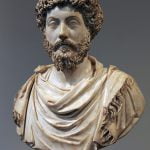In Yorkshire (England), the first archaeological evidence of the existence of the Roman upper classes in northern Britain was discovered.
Scientists have unearthed the remains of a previously unknown small town that contained both Roman and local structures. The centre was discovered about 65 km north of York; near the capital of the Brigant tribe. In the area of the ancient city, numerous remains of the Roman presence were found: glassware, beautiful tableware, imported drinking bottles, glass dice, part of a copper mirror or fragments of amber sculptures.
Historical sources mention that the Romans gave the queen of the Brigantes (43-69 CE) – Cartimandua, large treasures to ensure her support for the Roman cause and suppress any British resistance. It is worth mentioning that Britain was a mixture of numerous tribes that partly agreed to the supremacy of Rome on the island or rebelled. To maintain its influence, Rome had to rely on numerous alliances, bribes or “divide and conquer” policies.
Scientists believe that the treasures found could have been a form of bribery of Kartimandua and the local aristocracy at a time when Rome had not yet stabilized the situation in the northern regions of Britain.
Archaeologists added that the Roman buildings in the centre were probably built in the mid-50s CE and were directed to the road, which in turn was used mainly for military purposes. Scientists have also discovered an early Roman fort.







